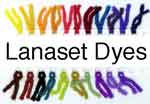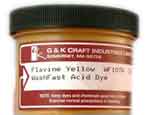Turning red cashmere to brown
Turning red cashmere to brown
Name: Amanda
— ADVERTISEMENTS —
Acid Dyes

(For wool, cashmere, angora, mohair, silk, & nylon)
Lanaset dyes
are the most washfast of all dyes for protein fibers. Rich, deep colors.Buy from
Washfast Acid dyes
at Paradise Fibers

Washfast Acid dyes
Designed to permanently dye protein fibers -- animal fibers like wool, silk, angora, mohair, alpaca and nylon. These brilliant shades are carefully selected from available super milling and premetalized colors. They have excellent wash and light fastness properties.
at Paradise Fibers

Washfast Acid dyes
Designed to permanently dye protein fibers -- animal fibers like wool, silk, angora, mohair, alpaca and nylon. These brilliant shades are carefully selected from available super milling and premetalized colors. They have excellent wash and light fastness properties.
Country or region: North America
Message: Hi there-
I was lucky enough to stumble onto a very inexpensive red cashmere ball gown. I've worn it to a few occasions and have since decided I'd like to use the yardage to create a throw or blanket. But, its red. Really red. Not that I necessarily have anything against the color but its a bit bold for my style of decorating. I've come to ask if you had advice or experience on how I could dye or otherwise change the color of my many yards of red cashmere. I'd be looking to achieve something in the brown family... so not sure if I'd need to take a step to dull or remove some of the red or if I can skip straight to taking it to "brown"... I'd love any tips or product recommendations.
I was lucky enough to stumble onto a very inexpensive red cashmere ball gown. I've worn it to a few occasions and have since decided I'd like to use the yardage to create a throw or blanket. But, its red. Really red. Not that I necessarily have anything against the color but its a bit bold for my style of decorating. I've come to ask if you had advice or experience on how I could dye or otherwise change the color of my many yards of red cashmere. I'd be looking to achieve something in the brown family... so not sure if I'd need to take a step to dull or remove some of the red or if I can skip straight to taking it to "brown"... I'd love any tips or product recommendations.
I like this project, because you're not set on keeping the gown exactly the size it is now, which is always a difficulty in redyeing ready-to-wear clothing that's made of wool and other animal-source fibers. Dyeing cashmere is not at all difficult, as long as shrinkage is not a huge issue. You will, however, need to keep sudden temperature changes to a minimum, and avoid excessive agitation, in order to avoid felting (though felting on purpose is another option that's well worth exploring).
The right type of dye to use for cashmere is acid dye. Acid dyes are the best dyes for all animal fibers, such as cashmere, wool, and angora (and, oddly, for nylon as well, but no other synthetic material). Acid dyes can be used with various helper chemicals, the most prominent of which is a mild acid, such as white vinegar. Acid dye works best when applied by heating the fabric together with the dye.
The best way to apply acid dye to cashmere or another protein fiber is in an enormous cooking pot, one large enough for the fabric to move in freely, and yet not made of a cheap material like aluminum, since aluminum reacts with auxiliary dye chemicals such as vinegar; a dyeing pot should be made of either stainless steel or unchipped enamel. You should not plan to reuse a dyeing pot for cooking, so it's an awfully great investment for an occasional dyer. However, it is possible to use acid dye at a lower temperature, such as that found in a washing machine (with the water heater turned up high, if possible), or even to improvise a suitable dyeing pot by pouring boiling water into a large, inexpensive, but water-tight styrofoam cooler.
There are many different acid dyes in the world. Even food colorings are types of acid dyes, which can actually be used as textile dyes, on protein fibers, but they are not as good as other types of acid dyes, and I do not recommend them for your project because the colors they produce are not always dark enough, and they tend to wash out easily. The acid dyes I most recommend for your purposes are the Lanaset dyes (see "Lanaset Dyes: A Range of Reactive and Acid dyes for Protein Fibers") and the WashFast Acid Dyes. Another good line of dyes is the Jacquard Acid Dyes. All of these dyes are best purchased by mail-order. You can buy dyes locally that will work, on cashmere, such as Rit All Purpose Tint and Dye, which contains some acid dyes in its mixtures, but the colors are not as predictable and the performance of the dye is generally inferior to the mail-order dyes. When you choose a dye, find a good recipe that is specifically written for that type of dye, so that you can follow it closely. Following a good recipe carefully is the way to ensure success in dyeing.
A bright red material, such as the cashmere you have now, cannot to dyed to just any color. Since dye is transparent, each color you apply will continue to show the former color through it. Red is a very intense color, and can be turned only to colors that contain it. You have a choice of darkening your red to a maroon dark red color, or overdyeing it with green or brown to produce various shades of brown (similar to what you'd get if you combined that shade of watercolor paint with that shade of green or brown paint). If you overdye your red with blue, you will get a purple, though it will be a subtler, darker purple than would be possible if you started with a bright bluish pink. If you overdye with black, you will get a darker red, or, if you use enough black, and are very careful to follow your recipe correctly, you can end up with black cashmere. Colors that are not possible include any lighter color, such as yellow, beige or orange, as well as any other color which does not contain red, colors such as green or blue. Sicne you're thinking of dyeing your cashmere brown, thise project is very doable. Some shades of brown do not contain enough red to be reachable for you, however, in which case you would need to remove some of the color first.
You probably already know that you must never apply household bleach to cashmere, wool, or any other animal fiber, or indeed to most synthetic fibers, but there are other color removing chemicals that may be safely used on protein fibers. (See "What chemicals can be used to remove dye?".) The best color remover for removing dye from protein fibers is the one found in the products Formosul and Rongalit, because it can be used at a low pH, which is kinder to proteins than anything that is used at a high pH. (Here is a link to ProChem's instructions for using Formusol [PDF].) If you use formosul on your red cashmere, chances are good (though never guaranteed) that enough of the color will be removed to allow you a much wider choice of colors, when you redye it. However, this is enough trouble that you may prefer to choose a shade of brown that does not require you to remove the existing color first.
Good mail-order sources for acid dyes and dyeing chemicals in Canada include G&S Dye and Maiwa Handprints; they sell different ranges of products, so take a look at both. For links and contact information for these and other retailers of supplies for dyeing, see my page, "Sources for Dyeing Supplies Around the World".
Posted: Monday - November 29, 2010 at 07:11 AM
Follow this blog on twitter here.
Quick Links
- All About Dyes & Dyeing Top -
- Top of this blog -
- FAQ -
- The Dye Forum -
- How to Tie Dye - How to Batik -
- Books - Toys - Plants -
- Top of this blog -
- FAQ -
- The Dye Forum -
- How to Tie Dye - How to Batik -
- Books - Toys - Plants -
More in this category:
- -
Statistics
Total entries in this blog:
Total entries in this category:
Published On: Aug 29, 2012 02:49 PM
Total entries in this category:
Published On: Aug 29, 2012 02:49 PM